 Reversing Into a Side Road On the Left
Reversing Into a Side Road On the Left
Key Points
Check all round and then use MSM before moving off from start point.
Move forward fairly slowly so you can check:
into the new road for obstructions etc.
the severity of the corner.
Use MSM for pulling up 2 car lengths past the corner.
Prepare - adjust your seating position - select gear/find bite - look all round.
Make sure you are looking through the rear window before moving.
Keep looking as you move slowly back to point of turn - use nearside mirror to check distance from the kerb.
Check all round before steering at the point of turn.
Gentle movements of the steering wheel - to steer towards the kerb turn the wheel towards the kerb and to steer away from the kerb turn wheel away from the kerb.
Keep looking - mainly in direction of travel but checking up and down the road.
Half way round the corner hold the lock - keep moving slowly and maintain your observations.
As you come parallel in the new road take the steering lock off to straighten up.
Keep looking and use the nearside mirror to check your distance from the kerb.
Drive back about 4 car lengths and come to a halt.
Re - adjust your seating position if necessary and remember your normal checks before moving off.
Remember to give way to other road users throughout the manoeuvre and it may be necessary to go back to the start point if another vehicle cannot get past you once you have begun the turn.
Summary
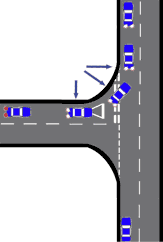
This tutorial has introduced you to the reverse left manoeuvre. Learner drivers can find this exercise awkward to learn so try not to be frustrated if you find it difficult at first - by the time you come to learn the reverse left your car control skills will be quite well developed and you may well have forgotten how difficult these skills were to learn when you first began training. This exercise is largely dependant on judgement, and accurate judgement can only be learnt by experience.
Remember the key to successful manoeuvring is using strict control over your speed to give time to assess your position on the road and in relation to others and to allow you to make minor adjustments when necessary.
We will have plenty of practice throughout the remainder of your training using corners with varying degrees of difficulty to ensure you develop the confidence to tackle the exercise in any circumstance.
Speed Control
Reversing and manoeuvring are not difficult to master, it just needs practice until you become confident. The secret is to ensure the vehicle moves slowly enough so that the steering movements will have greatest effect, you will find the vehicle responds differently in reverse gear because you can't feel the car turning with the steering and you will have to wait for the steering to take effect.
When we are manoeuvring in a confined area in first or reverse gear we need to maintain close control over the speed. Reversing slowly will enable you to have time for unhurried control of the vehicle and be able to make the necessary checks to the front, side and rear, this is done by controlling the clutch pedal and using the brake when necessary.
Can you remember how to control the vehicles' speed using the clutch?
Observations
Effective observations are crucial in the execution of any manoeuvre and the reverse to the left is no exception.
Moving off from the start position is like any other move off - check all round (including the blind spots), give way to any other vehicles or pedestrians and use the MSM to move off.
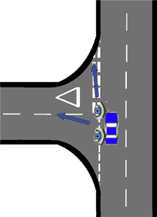
As you move past the road we are going to reverse into check for any obstructions or things like children playing which would make it impractical to carry out the manoeuvre. Use this opportunity to assess the point and degree of sharpness of the turn.
Use the MSM routine to pull up just past the new road (take care with the timing of the signal).
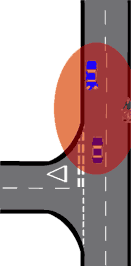
Before moving in reverse adjust your seating position, look all round and give way to other road users if there are any in the area. Whilst reversing we will be looking mainly over the left shoulder out of the rear window, but will be making checks up the road and down the road for any other road users and using the nearside exterior mirror to check on our position in relation to the kerb. Once we're moving what will we be looking for?
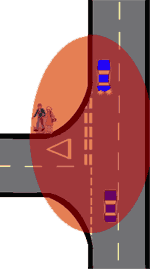
Just before the point of turn we need to look all round (remember the front of our vehicle will swing out into the road), if we do encounter any traffic or pedestrians we'll wait for them to pass before continuing. In the new road we would wait for any pedestrians to finish crossing the road.
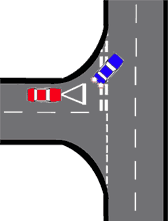
If any traffic approaches from behind and cannot get round us we wll have to go forward and back to the start point to allow them to clear the area.
Steering & Accuracy.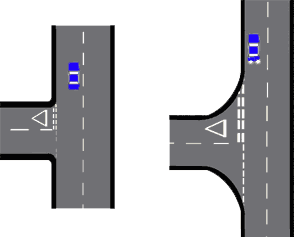
As you move forward from the start position you should take note of the severity of the corner because this will affect the amount of steering you will need to apply. The sharper the turn the more steering will need to be applied and the further you will need to be away from the kerb when you pull up past the road we are going to reverse into. The normal position (which will be the position on the type of corner we will be using initially) is about 2 feet from the kerb.
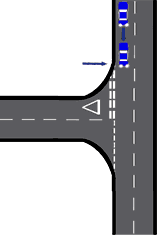
Once we start to reverse we will go in a straight line until the rear wheels are in line with the point of turn which is the point where we come level with the first curved kerbstone on the corner. When we learn how to do the manoeuvre in the car I will show you how to judge this position, but for now if you can try to remember that your rear wheels are located under the rear side windows, you will have a basic mental picture of how to judge your position.
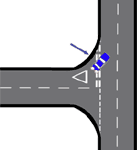
Now we'll start to make the turn - we'll be trying to maintain the same distance from the kerb throughout the exercise (you can use the nearside exterior mirror to help judge your distance). Because we'll only be moving very slowly you'll only need to apply the steering slowly and gradually using small movements of the steering wheel to adjust your position.
Once we're half way round the corner - hold the steering lock until the car is almost parallel to the kerb in the new road (I'll show you how to recognise the position in the lesson) then straighten up - however much steering has been applied to make
the turn is how much will need to be taken off to straighten us up.
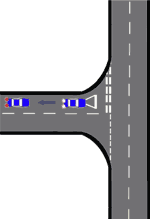
Once we are parallel in the new road we'll reverse a short distance (about 4 car lengths) into the new road and come to a stop about the same distance from the kerb as we were in the starting position.
Throughout the exercise we'll be making sure that we don't hit the kerb or stray onto the wrong side of the road - many people find it confusing to remember which way to turn the wheel when manoeuvring in reverse - try to remember "To steer towards the kerb turn the wheel towards the kerb and to steer away from the kerb turn the wheel away from the kerb".
Introduction
This tutorial will introduce you to reversing into a side road on the left. Your training and car control skills will be fairly well advanced before we learn this manoeuvre and you will have had some practice of manoeuvring using reverse gear.
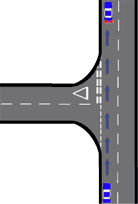
The manoeuvre starts from a parked position just before the road we are going to reverse into. We'll move off, drive past the road we are going to use for the exercise and make a normal stop about 2 car lengths past the turn.
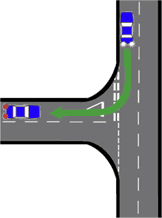
Then select reverse gear and drive around the corner keeping reasonably close to the kerb.
Once in the new road we'll straighten up and drive parallel to the kerb for a short distance (about 4 car lengths) before making a normal stop.
You will probably have learnt at least one other reversing manoeuvre before this point in your training so you should be getting familiar with the need to consider the following points before beginning any manoeuvring exercise. Think about some of the things that may prevent you doing the reverse left in relation to these points and then check to see if you're thinking along the right lines:
Content fo class "content80" Goes Here